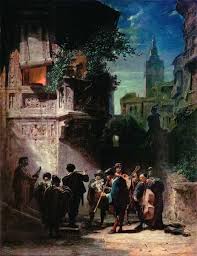세레나데는 사랑을 담은 음악입니다. 세레나데는 ‘음악으로 바치는 인사’라는 아름다운 생각에서 시작되었습니다. 주로 저녁 시간에, 특별한 이들을 위해서 야외에서 연주되는 음악의 전통이 18세기의 세레나데로 이어졌습니다. 세레나데로 인사를 받은 이들은 주로 인사를 바치는 이의 애인이거나 지위가 높은 사람이었습니다. 귀족 사회의 여흥음악으로 사랑을 받았던 세레나데의 전통은 신분제가 폐지된 이후에도 지속되었습니다.
1777년 출판된 하이든의 초기 현악 사중주 Op. 3, no. 5의 2악장 안단테 칸타빌레에는 오늘날 기악 세레나데의 전형이라고 할 만한 특징들이 들어있습니다. (오늘날 하이든 학자들은 이 작품이 하이든이 작곡한 것이 아니라, 로만 호프슈테터Roman Hoffstetter가 작곡한 위작일 것이라고 추정한다.) 피치카토 반주를 타고, 제1바이올린이 전형적인 갈랑풍의 우아한 노래를 연주합니다. 발현악기(뜯어서 소리 내는 현악기. 즉 류트, 만돌린, 기타.)의 반주를 연상시키는 음악에는 ‘세레나데’라는 제목이 붙을 수 있었습니다.

시초는 이탈리아에서 창 너머로 사랑하는 연인에게 마음을 전하는 음악이었습니다 세레나데는 17-18세기에 이탈리아에서 발생한 연흥을 위한 가벼운 연주곡을 일컫는 말입니다. '저녁음악’이라는 뜻으로, 본래는 옥외 음악이었던 것이 뒤에는 연주회용 악곡으로 되었습니다. 이탈리아에서는 세레나데라는 이름 이외에 디베르티멘토 (Divertimento, 여흥, 기분전환), 노투르노 (Notturno, 야상곡), 카사티온 (Kassation, 휴식) 등으로 불렸습니다.
성악의 세레나데에서는 해거름에 사랑하는 여성이 기대고 있는 창가에서 남성이 부르는 사랑의 노래이며, 기악에서도 해거름의 휴식 때에 사람들에게 들려주기 위하여 만든 음악을 세레나데라고 합니다. 그 뒤로 관현악 모음곡과 고전모음곡의 중간적 성격을 갖는, 악장의 개수가 많은 세레나데도 쓰였습니다. 모차르트의 13곡의 세레나데 (13번인 《아이네 클라이네 나흐트무지크》 포함)는 이 종류의 전형적인 형태입니다.
19세기 작곡가들은 세레나데를 그 자체로 하나의 음악 형식으로 받아들이기 시작했습니다. 음악의 기능적 목적만을 생각하는 것에서 벗어나 예술적 가치를 찾기 시작한 것이죠. 왈츠가 쇼팽에 의해 단순한 춤곡에서 벗어나 연주를 위한 독자적인 장르가 되었던 것과 비슷하다고 할 수 있습니다. 차이콥스키의 ‘현을 위한 세레나데’는 이러한 시대적 흐름에 정확히 부합하는 작품입니다. 제목처럼 현악기들만으로 연주하게 되는 이 곡은 총 네 악장으로 구성되어 있으며 특유의 애수 어린 선율과 우아한 왈츠, 러시아적인 요소 등 차이콥스키만의 작곡 능력이 유감없이 발휘되고 있습니다.
드보르작이 작곡한 현을 위한 세레나데는 차이콥스키 못지 않은 인기를 누리는 곡이죠. 동유럽 특유의 우수 어린 감정이 흘러내리는 이 작품은 오늘날 세계 각지에서 자주 연주되는 인기 레퍼토리 중 하나이고, 특히 2악장 왈츠는 영화나 드라마, CF 등 다양한 미디어에서도 활용될 정도로 아름다운 선율이 특히 인상적입니다.
세레나데는 한자로 풀면 소야곡 (小夜曲)입니다. 저녁이나 밤에 창 밖에서 연인에게 부르는 사랑 노래를 의미합니다. 세레나데를 독일어로 표현하면 아이네 클라이네 나흐트무지크 (eine kleine Nachtmusik)입니다. 이는 '세레나데’를 의미하는 말입니다.
The Andante Cantabile, the second movement of Haydn's early string quartet Op. 3 and No. 5, published in 1777, contains certain characteristics that are typical of today's instrumental serenades. (Today, Haydn scholars estimate that the work is not composed by Haydn, but a forgery by Roman Hofstetter.) Riding with a picci-cato accompaniment, the first violin performs an elegant song with a typical galang style. Music reminiscent of an accompaniment of a sympathetic instrument (a lute, mandolin, guitar.) could be entitled "serenade."
It started with music that conveyed one's heart through a window in Italy. Serenades are lighthearted performances for entertainment that occurred in Italy during the 17th and 18th centuries. Meaning "evening music," what was originally outdoor music became recital music later. In Italy, in addition to the names serenades, they were also called "Divertimento," "Noturno," and "Kassation."
In the "Serenade of Vocal Music," it is a love song sung by a man at a window where a woman in love leans on the haebeam, and in instrumental music, music created to play it to people during the haebeam's break is called a serenade. There were also many serenades in the movement, which had the intermediate character between orchestral composition and classical composition. Mozart's 13 serenades (including "Eine Kleine Nachtmusik," No. 13), are typical of this kind.
In the 19th century, composers began to accept serenades as a form of music by themselves. They started to find artistic value, moving away from thinking only about the functional purpose of music. It can be said to be similar to how the waltz became an independent genre for performance, rather than just a dance song by Chopin. Tchaikovsky's "Serenade for String Orchestra" is a work that fits the trend of the times exactly. As the title suggests, the song, which is played only with strings, consists of four movements, and Tchaikovsky's unique compositional ability, including his sorrowful melody, elegant waltz, and Russian elements, is fully displayed.
Dvorak's "Serenade for the String Orchestra" is just as popular as Tchaikovsky's. The piece, which is unique to Eastern Europe and has young emotions, is one of the popular repertoires that are often played around the world today, and the waltz of the second movement is particularly impressive with beautiful melodies that are used in various media such as movies, dramas, and commercials.
Serenades are "小夜曲(soyagok)" in Chinese characters. They are love songs that are sung to lovers outside the window at night or in the evening. Serenades can be described in German as "eine Klein Nachtmusik." It means "serenades."
'Music Story' 카테고리의 다른 글
| 열렬한 도전자, 베를리오즈(A fierce challenger, Berlioz) (155) | 2024.07.07 |
|---|---|
| 「자장가」 K 350(C 8, 48) (139) | 2024.06.30 |
| 베버의 작품세계(The world of Weber's work) (69) | 2024.06.25 |
| 음악을 향유하는 우리의 의무(Our duty to enjoy music) (192) | 2024.06.17 |
| 음악은 마음의 날개(Music is the wing of the heart) (180) | 2024.06.10 |



